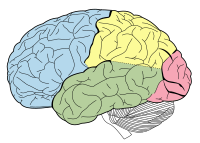
Photo from wikipedia
Freezing of gait (FoG) in people with Parkinson's disease (PD) is an environmentally sensitive, intermittent problem that occurs most often during turning. FoG is difficult for clinicians to evaluate and… Click to show full abstract
Freezing of gait (FoG) in people with Parkinson's disease (PD) is an environmentally sensitive, intermittent problem that occurs most often during turning. FoG is difficult for clinicians to evaluate and treat because it can be difficult to elicit during a clinical visit. Here, we aimed to develop a clinically valid objective measure of freezing severity during a 2-min 360-degree turning-in-place. Twenty-eight subjects with PD (16 freezers, FoG+, and 12 nonfreezers, FoG-) in the "off" state and 14 healthy control subjects were tested. Subjects wore three inertial sensors (one on each shin and one on the waist) while (1) turning in place for 2 min (alternating 360 degrees to the right with 360 degrees to the left) and (2) performing an Instrumented 7-m Timed Up and Go test (ITUG). Performance was videotaped, and clinical severity of FoG was independently rated by two movement disorders specialists (co-authors). Turning in place consistently resulted in FoG (13 out of 16 subjects with PD) while FoG was clinically observed in only two subjects with PD during the ITUG test. The Freezing Ratio during the turning test was significantly correlated with the clinical ratings (ρ=0.7, p=0.003) and with score on the new FoG questionnaire (ρ=0.5, p=0.03). After correcting for symptom severity (UPDRS-III), out of the four objective measures of the turning test (total number of turns, average turn peak speed and average turn smoothness), only the Freezing Ratio was significantly different across groups (p=0.04). Freezing can be well quantified with body-worn inertial sensors during a 2-min turning-in-place protocol.
Journal Title: Neuroscience
Year Published: 2017
Link to full text (if available)
Share on Social Media: Sign Up to like & get
recommendations!